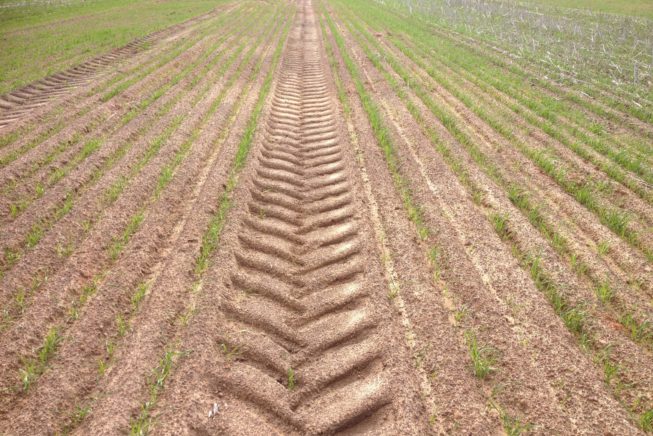Soil Compaction can be a limiting factor, but you don’t know what you have until you see what’s under the surface.
As you’re starting to wrap up the harvest for the season, right now is the best time to see if you have maximized yield.
Check for soil compaction as this can influence root depth and accessible water, and can seriously restrict accessibility to supplements as the plants can’t get to them.
As farms and tractor sizes get bigger, we should remind ourselves that compacted soils, if not dealt with, can come and bite us in the backside.
Get your shovel out
Use a shovel to feel any compaction and to look at your roots’ growth and growth pattern.
The surface layer can be impacted by too much tillage, no surface residue and destroyed soil structure. This can leave the surface particles vulnerable to raindrop impact. Raindrops behave as little bombs when falling on exposed or bare soil, displacing soil particles and destroying soil structure. The soil acts like a kitchen linoleum floor that does not absorb water quickly.
This stops yield-producing rains from getting to the roots and keeps out critical oxygen, thus the roots have trouble taking up nutrients and growing. and stripping the surface layer so that stones and subsoil stay behind. This is so common that some farms think of it as normal, but it is not and it will greatly affect your yields.
On the other hand, dying roots and hollow stems can improve soil health. These contain macropores, which drain freely by gravity and allow easy movement of water and air. They provide a habitat for soil organisms and plant roots can grow into them. With diameters less than 0.08 mm, micropores are small soil pores usually found within structural aggregates.
Dig Deeper
The next layer down you can often feel with a shovel or soil auger. As you dig, the soil breaks horizontally, and there are very few roots below. These ‘hard pans’ are especially prevalent in fields that are chiselled or disked.
You can often feel the ‘pan’ at 7-10cm down. Hard pans restrict root growth and make it difficult for water, air and other gases plus soil organisms to move up and down. They are caused by tilling to a particular depth or by several other factors.
A huge amount of plant photosynthesis is not going to yield by trying to force the root through compacted soil. Tillage often hides this top-layer destruction. On many farms, we’ve seen producers break up large blocks of soil on the surface layers to make brick and tennis ball-size compacted blocks. This is not loosened, friable, well-structured soil.
Getting to the root causes of compaction
You can’t solve a problem if you don’t know the problem. A simple computer hard soil analyzer (called a shovel for us old guys) can show if you do have a problem.
Finally, we get to why we were digging in the field: accessing root depth. Armour Group has had experience in farms where a shovel is put in and seemingly hits a stone in multiple spots and stops at around the 10cm mark. There is no stone, but there was a roadbed of compacted soil that completely limited rooting depth.
The importance of tractor weight and tyres
In many cases, the deep compaction is made worse by spreading manure with a spreader that has too few axles for the load and/or too high tyre pressure to effectively support the weight.
Tyre pressure equals surface compaction, and axle load equals deep compaction. Drag hose injectors can take a lot of that compaction weight off, but operating it when the soil is not dry will put a lot of that compaction back in.
Finding the Right solutions
Once you find compaction, the first reaction is to look for the biggest, deepest ripper, and a monster tractor to tear it all out! However, as some research from New Zealand has found, without changes to the rest of your cropping system, this will be a complete waste of time.
Without knowing what’s going on underground, you may be doing more damage than good.
Lots of black smoke and lumps on the surface won’t improve anything. And running a chisel plough deeper than its designed depth will horizontally compact the soil.
Improving fields takes strategic planning. It all needs to be done when the soil profile is dry enough to shatter.
Beyond soil compaction, soil organic matter influences the nutrient supply and water-holding capacity in soil. Nutrient release from freshly added residues (stubbles, green and brown mulches, manures) can also occur and depends on the quality of the decomposed material and its carbon-to-nitrogen ratio (C:N ratio).
We need to minimize soil disturbance, chemical, physical, keep armour on the soil, keep a living root as much as we can and get as much diversity into the system as possible.
One part of the process is to deep-till in winter (if dry) and immediately drill winter triticale as winter forage. The massive roots will brace the soil, keeping them open to start the process of improving soil structure. If you haven’t done this yet, plan it ahead of the season to maximise the time for tillers to grow, and to produce above- and belowground biomass.
The fewer trips it takes to get the crop in, the more you can wait for the right conditions to work or plant the field.

